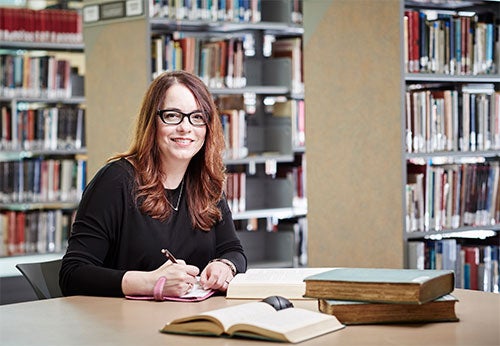History prof takes teaching beyond the traditional essay
Birthing chair and stained glass replica of a saint’s window are just two of the student projects that bring history to life in Greta Kroeker’s class
Birthing chair and stained glass replica of a saint’s window are just two of the student projects that bring history to life in Greta Kroeker’s class
By Suzanne Bowness Marketing and Strategic CommunicationsLooking around Greta Kroeker’s office, you might think that the pre-modern birthing chair and the stained glass replica of Teresa of Avila’s convent window are artifacts from the associate history professor’s research trips. In fact, they are artifacts of her teaching — both objects were made by students in Kroeker’s third-year “Witches, Wives, and Whores” course.
“I believe that the most successful classroom learning happens when we let students follow, as much as possible, their own interests and play to their own strengths,” says Kroeker.

This year Kroeker was nominated by her students for the university’s annual distinguished teacher award. An early modern history specialist, Kroeker came to Waterloo in July 2007 via Virginia Tech with a PhD from the University of California at Berkeley.
Kroeker has long viewed her classroom as a lab where students pursue research projects that go way beyond the traditional essay. Other than a requirement to be based in research and footnoted, she lets their imaginations dictate the rest. “The idea is to allow students to connect as much as possible with what the actual lives of pre-modern women would have been like,” says Kroeker.
In addition to the birthing chair and convent window, some of the projects include:
Kroeker says she gains her teaching inspiration from many places, including past professors, her teacher parents, her educational specialist sister, and her best friend who teaches pre-kindergarten. “I nag people about their teaching all the time. I borrow rigorously. I'm happy in the classroom and I look at other people who are happy in the classroom and I try to find out what they're doing because that usually means it's a good experience for everybody,” says Kroeker. At Waterloo, the Centre for Teaching Excellence and subject matter librarian Jane Forgay are great supports.
She also felt supported by her students when she found out about the teaching award. “That students took the time and energy and effort to honour me in that way means the world to me. I still get goose bumps thinking about it. I'm just so grateful. It's one of the most significant things that's happened in my life.”

Read more
Meet the 14 exceptional students representing Waterloo’s newest grads

Read more
“I’m excited to be in a place where I’m adding value, learning fast and living up to the Waterloo reputation of pushing boundaries.”

Read more
More than 100,000 children and youth from across the region are discovering the wonders of science and technology through the University of Waterloo
The University of Waterloo acknowledges that much of our work takes place on the traditional territory of the Neutral, Anishinaabeg, and Haudenosaunee peoples. Our main campus is situated on the Haldimand Tract, the land granted to the Six Nations that includes six miles on each side of the Grand River. Our active work toward reconciliation takes place across our campuses through research, learning, teaching, and community building, and is co-ordinated within the Office of Indigenous Relations.